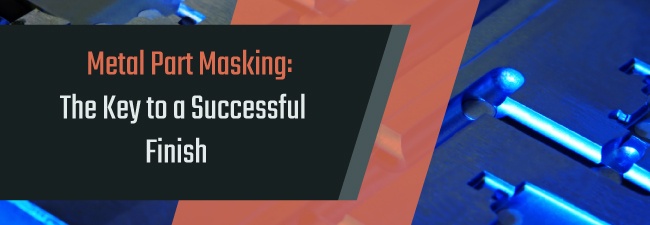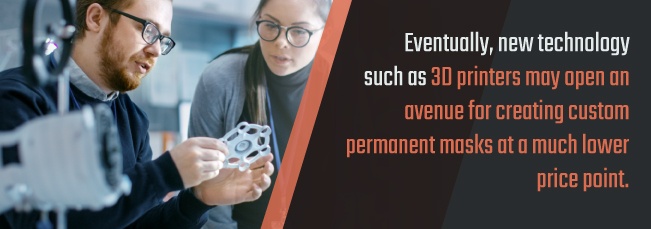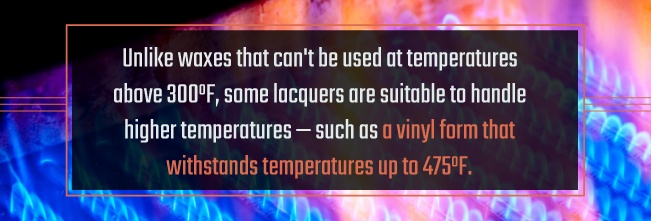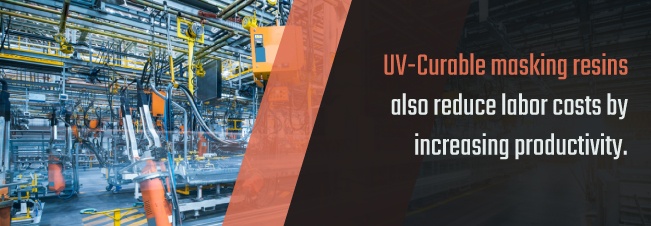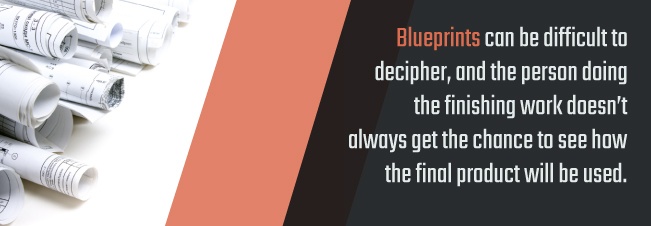Sometimes when surface finishing an object, you don’t want the entire exterior coated. The solution is the precision process of metal part masking. Masking for surface finishing presents many challenges. Solving these challenges means choosing the right type and method for your mask as well as developing an understanding of the most common masking issues and their solutions.
What Is Metal Part Masking?
Metal part masking prevents certain areas of an item from being electroplated, maintaining that object’s integrity and function. Masking ensures the finishing material goes exactly where you want it to and nowhere else. The following are several scenarios where masking would be required.
- Preserving threading: Threading allows parts to be screwed together, and thread dimensions must be precise. Anodizing can change these dimensions, especially when the finishing process is being used to increase the thickness of the rest of the part. Masking ensures threads remain intact.
- Preserving electrical contacts: Anodizing can act as an insulator, which means allowing the plating to reach electrical contacts can stop the piece from working correctly. Masking, such as for silver plating, becomes vital to preserving the piece’s ability to conduct a current.
- Allowing a part to receive a mix of coating processes for precision results: Some parts require precision plating and will receive different layers of finish. The finisher may need to apply these additional layers to some surfaces but not others. Thus, some parts may be masked later in the process, after receiving the first or second layer of finish. It all depends on what the part is used for, the metal it’s made of and the needs of the project.
- Applying a logo or other design element: In some cases, you can also use masking to add a logo or other design element to an object. By masking the required area then removing the mask after the plating has been applied, you ensure the specific design you want incorporated will remain.
Should I Use a Temporary or Permanent Masking Method?
The majority of projects that require masking use temporary masks made of waxes, tapes and lacquers. Other types of temporary masks exist as well, such as magnetic masks or UV-curable masking resins. Any of these options are considered to be temporary because you use them specifically for each project, then they’re removed and disposed of upon the finishing’s completion. These masks offer versatility, but they must also be created for each project.
Permanent masks are another masking option. They’re more expensive and may need to be custom-created, but in some cases, they can be more beneficial to a project than temporary masks. Permanent masks are often made of rubber or silicone, and they’re designed to withstand the harsh chemical baths and higher temperatures they’ll encounter.
Use a permanent mask when you have a large production run that will use the same shape on the same part on a regular basis or when an off-the-shelf-shape will do. Permanent masks may also be used when the mask requires such a precise geometrical shape that attempting to recreate the shape on multiple occasions would require more time and labor than would make sense.
Since permanent masks are reusable, they’re less wasteful, but they can still be more expensive than temporary options. Eventually, new technology such as 3D printers may open an avenue for creating custom permanent masks at a much lower price point. So far, however, masks created on 3D printers have been unable to withstand the extreme temperatures required by most finishing applications.
When you’re trying to choose between temporary and permanent masking, the biggest determinant will be the project itself. The cost, time and final design required all factor into whether or not temporary or permanent masking is best. Even the condition and type of surface you’re plating can play a role in the success of the masking method. For example, it’s easier to get certain masks to adhere to a rougher surface.
What Are the Most Common Masking Methods?
Temporary masking is what you see for most plating projects, and common temporary masking methods include wax, liquid and tape.
1. Wax Masking
You’ll find two types of wax masking options for electroplating:
- Petroleum-based low-temperature waxes
- Chlorinated synthetic high-temperature waxes
You must pay close attention to the temperature of your dip when using a wax-based mask. Petroleum-based low-temperature waxes can be used when your dip will heat to 150 degrees Fahrenheit or less. Chlorinated synthetic high-temperature waxes will work best at temperatures as high as 300 degrees Fahrenheit.
Waxes carry a few distinct advantages. They:
- May be salvaged and reused
- Are easy to remove
- Can be worked into a variety of shapes
- Are inexpensive
However, waxes are unsuitable if you need to do any anodizing at temperatures above 300 degrees Fahrenheit. You must also have some skill to use waxes because they need to be trimmed to fit precisely in the space you’ll be masking.
2. Liquid Masking
Liquid masking for anodizing is another option. Stop-off lacquers are the most widely used liquid masking method, and these lacquers are especially good for electroplating. They have advantages that make them suitable for a wide variety of applications, including that they’re:
- Easy to apply and remove
- Able to work into hard-to-reach places
- Available to be brushed or sprayed on to conform to a variety of shapes
Despite ease of application, lacquers still require skill. Timing is everything, and novices often proceed to anodize the part before the lacquer has an opportunity to dry. Another challenge when working with lacquer is that it’s easy for it to end up in areas you don’t want.
Unlike waxes that can’t be used at temperatures above 300 degrees Fahrenheit, some lacquers are suitable to handle higher temperatures — such as a vinyl form that withstands temperatures up to 475 degrees Fahrenheit.
There’s a wide variety of lacquers on the market, and each one is designed for different applications. You might choose one kind of liquid masking for anodizing, for example, and another one entirely for electroplating or for silver plating masking. Make sure you understand what the lacquer you’re choosing was designed to help you accomplish.
3. Metallic or Non-Metallic Tape Masking
Tapes are another masking method, and they also tend to be the most popular for a variety of reasons. One such reason is that some tapes, especially glass tapes, work well at high temperatures — up to 450 degrees Fahrenheit — offering an alternative to waxes and lacquers. Additionally, while they can be time-consuming, tapes are also generally the easiest to apply.
If you’re using tape as your masking method, you have the option of metallic or non-metallic, depending on what your project requires. Use metallic tape when you want to draw current away from the area you plan to plate, and use non-metallic tape as an insulator.
The advantages of metallic and non-metallic tape are that they:
- Provide ease of use
- Tolerate heat
- Are cost-effective
- May be cut into a variety of shapes
You must take care when applying tape, however, as it’s prone to tearing. Torn tape can result in an incomplete mask, ruining the part.
One disadvantage of tapes is the labor associated with getting them properly applied. They can take more time and care than most other masking methods.
You should also be aware that it can be hard to choose the right tape. You have to balance the thickness of the tape, which determines how much protection it offers, against its flexibility, which determines how well it will cover any areas on the object that are hard to reach. If you’re going to choose tape as your masking method, consider reaching out to a qualified expert to provide further guidance.
UV-Curable Masking: An Emerging Solution
Like all industries, the metal finishing industry continues to evolve. We’ve covered the tried-and-true methods, but finishers now have access to another masking method: UV-curable masking resins. These resins offer significant advantages to finishers. They:
- Can be cured in seconds
- Are non-flammable
- Are toxin-free
- Leave no residue
- Do not present a danger to employees
- Produce no hazardous waste
These resins also reduce labor costs by increasing productivity. Rather than waiting for a lacquer to dry or spending hours struggling with tape, finishers can simply cure the resin with a blast of UV light. This strategy makes resins an attractive option, especially when compared to lacquers and other masking methods
If you wish to pursue this masking option, you’ll need to purchase a UV-curing system.
Resins may be removed either via peeling or burning. Either way, they can be removed with ease, and they don’t leave residues behind.
UV masking still doesn’t solve every major masking problem, however. For instance, the masks must be properly applied, and the blueprint has to be read correctly.
What Are the Most Common Masking Issues?
There are six issues you’ll encounter most often when you mask.
1. The Masking Is Unable to Handle the Finishing Temperatures
One of the most common masking mistakes is choosing a method that’s unable to withstand the temperatures your bath will reach. Be sure you understand both the limitations of your masking option as well as the maximum temperatures of your bath. You may need to select a more heat-resistant masking method.
Some masking materials, such as silicone, can withstand temperatures of up to 600 degrees Fahrenheit.
2. Plugs Fall Off or Out
If you find that wax plugs are falling off or out during the surface finishing process, find a flexible masking method or one less prone to this problem. Lacquers are an ideal temporary solution. If it’s cost-effective to do so, you may even consider a custom permanent masking solution.
3. The Masking Peels Before the Process Is Complete
A peeling mask is indicative of a surface that has not been pre-treated properly. Ensure the surface of your object is correctly prepared for the mask, and be certain your method will work with the material of the object.
4. The Masking Gets Where It Shouldn’t
When masking gets somewhere you don’t want it, it’s referred to as “accidental masking.” If you’re struggling with this problem, the solutions are relatively simple. You can start by ensuring your workstation is clean and organized. Doing so provides more space to work, allowing for more precise applications of your masking methods. Also, be sure to take your time and mask with care, especially with liquid.
5. An Object Has Areas That Are Hard to Reach
If you’re having trouble reaching the areas you need to mask, you’re not alone. Many finishers find this situation to be their number one problem. In circumstances where an object is a strange shape or has areas that are difficult to access, liquid masking can be ideal, but it may not work in all cases.
Sometimes a good finishing professional will just have to get creative. The endless variety of part designs makes it likely that some moments will present a challenge, even if you’re adept at choosing the absolute best masking method for the job every time.
The need to occasionally get creative is one reason a good finishing consultant can be invaluable. Finishers who have been in the business for a long time have seen almost every masking problem there is to see, and they’ve often already developed workarounds.
6. Blueprints Are Difficult to Understand
Blueprints can be difficult to decipher, and the person doing the finishing work doesn’t always get the chance to see how the final product will be used. If you’re not sure what needs to be masked, always get a second pair of eyes on the problem. Another expert may help you understand the engineer’s intentions.
In the end, the masking professional is ultimately responsible, so be certain you know what you’re doing before you proceed.
The Finisher’s Greatest Challenge: Choosing the Right Masking Solution
Masking is one of the greatest challenges in finishing, but it’s also unavoidable. If you need to anodize something, you’ll probably have to mask certain parts of it. Keeping costs down and avoiding part rejections means choosing the right method out of all the available options and getting guidance on the best way to apply that method to your project.
Sharrett’s Plating Company offers consulting services to save you time, money and errors. Put an SPC finishing and masking expert on your side to help you navigate the tricky ins and outs of masking for surface finishing.


